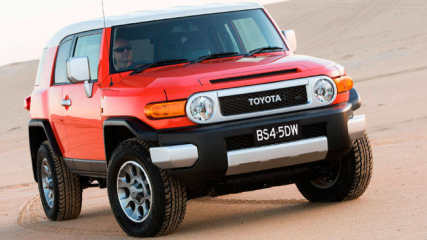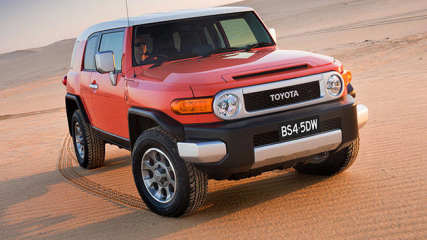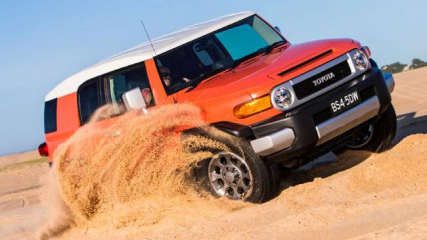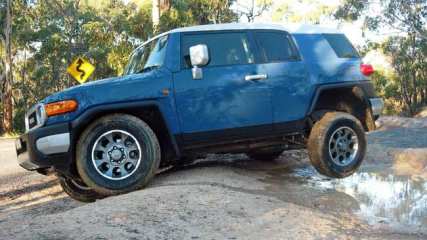Used FJ Cruiser review: 2011-2016
By David Morley · 13 Sep 2019
Retro designs don’t always work out the way the carmaker planned.But the Toyota FJ Cruiser is one that does, recalling the early Toyota LandCruiser of the 1960s and '70s that we remember so fondly.Launched in 2011, the car was only on sale here until late 2016 (after it flopped in the United States).By then, sales had slowed, and plenty were still hanging around showrooms well into 2017 and maybe even 2018.Even as late as this year, 2019, you still see the odd one with not much more than dealership demonstrator kilometres showing, and these can be great buys. The five-seater, off-roader with the old-school looks was actually based on the Toyota Prado, so it’s a very capable vehicle in any conditions.That’s why you see so many getting around with serious accessories and aftermarket features which can range from extra recovery points, a snorkel, winch, a tough bash plate (for better underbody protection than the factory provided) awning, chunky rims and tyres, bull bar, side steps, a light bar and other driving or spot lights.How much is a car loaded with accessories worth over a standard one? It all depends on the quality of those features and whether you want or need them in the first place.Basically, they can add greatly to the cost of an FJ Cruiser when adding them, but don’t always add the same amount to the resale value.On top of that, a heavily modified or accessorised vehicle suggests that it’s been used in the bush quite a bit, while more typical, soft-roader additions such as floor mats, tinted windows or a nudge bar speak of an easier life.Some of these fitments were available as dealer-fitted factory options, so check each vehicle carefully.Trim levels weren’t extensive in the FJ Cruiser and there’s really only one specification that includes gear like cruise control, VSC (stability control) power steering and a driver-operated diff lock.So forget about models within models, different sizes and different interior dimensions, design details, exterior fittings or seating layouts and concentrate instead on finding the best example by way of a direct comparison between individual examples. An FJ Cruiser is an FJ Cruiser, in other words.One area where you do have great choice is in the FJ Cruiser’s range of colors.This is where Toyota really let its retro heart rule, and as well as some old-school blue, yellow, red, orange, grey, black and green shades (all with a white roof) the hero hue was a throwback beige that mimicked perfectly those early LandCruisers. The FJ’s exterior dimensions (it’s shorter and lower than a Prado) play a big part in its storage capacity and boot space.A cargo-bay liner is a nice touch, but a cargo barrier can actually reduce versatility especially when carrying long loads.Many owners have fitted their FJs with drawers in the rear section to maximise storage and many others have resorted to the roof rails or an aftermarket roof rack for extra carrying ability.The bottom line is that the Toyota is not huge inside.How many seats you need will also determine whether you make use of the removable cushions on the rear seat which can open up a lot more space for luggage or recovery gear.Accessing that rear seat, meanwhile, involves a small, reverse opening rear-side door on each side.The catch is these can’t be opened without the front door being opened first, so it’s not as practical a layout as it might seem at first.Rather than use leather seats, Toyota went for a hard-wearing, semi-waterproof material that doesn’t look too odd beside the hard plastics that make up the rest of the interior.The basic sound system is just that; basic, but it does use eight speakers and incorporates a CD player and radio, but you can forget about a subwoofer, Apple CarPlay (iPhone) or Android Auto streaming.Similarly, there’s no push button start (although there is keyless entry) no touchscreen or DVD player.Meantime, you do get plenty of cupholders, air-conditioning, Bluetooth, power mirrors, power windows and an immobiliser.From early 2012, a GPS-based navigation system became standard which makes sense given sat nav is so important for the adventurers among us. While many carmakers like to offer a turbo-diesel engine, petrol engines that range in size and all sorts of motor layouts from four to eight cylinders, Toyota played a very straight bat with the FJ Cruiser.In fact, there was just one mechanical layout and that started with the 4.0-litre V6 petrol engine.The engine specs aren’t hugely impressive for such a big engine (it’s not a lot of horsepower for four litres, for instance) but the secret was in the way the 200kW of power and 380Nm of torque were delivered.The engine is well regarded in the trade and also runs a timing chain rather than a belt which should be good for the life of the vehicle.Plenty of owners fitted their FJs with LPG conversions, too, but some experts reckon the Toyota V6 doesn’t really like such conversions.And just as there was only a single engine offered, there was also just one gearbox, a five-speed automatic.The vehicle was aimed at the US market, remember, where the manual vs automatic debate is a forgone conclusion in favour of the auto.The towing specifications are pretty impressive, and the Cruiser has a towing capacity of up to 2250kg, although it should be said that this is well short of the latest dual-cab utes’ towing ratings.But that’s because the FJ is a bit lighter than those new utes at 1955kg and has a gross vehicle weight of 2510kg.Even so that’s still decent pulling power and the reason you see a lot of second-hand FJ Cruisers with tow bars fitted.Plenty for sale also have a dual battery system fitted which is great for camping, although the basic vehicle made do with a single battery.Since it was a proper off-roader, the FJ Cruiser got a fair dinkum 4WD system, not a 4X2 nor an AWD (all-wheel-drive) set-up like a lot of 'soft-roaders'.On bitumen, the FJ was a rear-wheel drive vehicle, but when things got tough and you selected 4WD, the Toyota got very serious with low-ratio gears and enormous off-road ability.Fuel tank capacity is important in vehicles like these which operate where service stations are few and far between.Which is why, if the budget will allow, you should look for a post-February 2013 built FJ Cruiser.That’s when Toyota more than doubled the fuel capacity by adding an extra 87-litre tank to the original’s 72-litre number.As well as giving the car enormous range potential, it means you don’t have to mess around fitting an expensive aftermarket long range fuel tank or carrying jerry cans. The biggest shock to those coming out of a conventional car and into a off-roader will be the fuel consumption.And it doesn’t matter how you express it (l/100km or km/l) the fuel mileage from the petrol V6 will always be a bit scary even on the freeway, where you can count on using around 11 or 12 litres per 100km. Off-road, in sand and mud, that figure can easily jump to 20 litres.But it’s the vehicle’s off-road review where it really shines with huge capability, including a wading depth of 700mm and 224mm of ground clearance, making an aftermarket lift kit only for really serious bush bashing. And even then…And if you buy the later model with the extra fuel tank, you’ll also get Toyota’s 'CRAWL' off-road system which uses the on-board electronic driver aids to maximise grip and traction.In fact, the standard rear diff-lock becomes a bit superfluous in a CRAWL-equipped FJ.On road, the FJ is a bit of a mixed bag.The large kerb weight means it has enough performance, but it’s still not a car built for speed, so 0-100 acceleration will still take about 10 seconds.The turning circle is pretty large for urban parking spots and if a previous owner has replaced the original tyres on the standard alloy rims with more aggressive rubber, they can contribute to a fair bit of road noise.In ride terms, it’s better news and the independent front suspension coupled with coil-sprung rear suspension does a better job than many vehicles of making a long journey comfortable. The FJ Cruiser isn’t included on ANCAP’s safety rating list and it’s not fair to simply take the Prado’s rating and apply that, because there are far too many structural differences between the two for that to be valid.But the FJ does get a full compliment of front and side air-bags, including curtain bags to protect all five passengers.You also get a reverse camera, ABS, brake-force distribution, brake-assist, stability control and traction control, but ISOFIX child restraint mounting points are not fitted. Being a late model Toyota as well as being based on the very well proven Prado platform, the FJ Cruiser is largely free of common problems.The body is not prone to rust and the faults and problems mentioned by owners and the experts are generally fewer than many other vehicles, helping to give the vehicle its terrific reliability rating.The fact that the FJ Cruiser was designed from the start to be a serious off-roader also means a high level of durability and inherent toughness.The petrol engine means the Cruiser is likely to impose lower service costs on its owner (compared with a modern turbo-diesel) but, as with any vehicle, make sure you check the owners manual and the service record to ensure that the car you’re looking at has been maintained correctly.The engine itself is proven and long-lived and automatic transmission problems also appear rare with no discernible pattern to be wary of.Ultimately, the FJ’s health and well-being as a used-car is likely to be down to how it has been maintained and, crucially, how it’s been used in the past.A car that has been driven extensively off-road, over rocks and through salt water is likely to be showing more wear than one that has been used for the school run.That’s especially so when it comes to the condition of the body and there are a couple of things to watch in this department.The full-sized spare tyre mounted on the rear door saves interior space but it is heavy and that can mean the hinges on the door can become a bit sloppy over time.If the rear door doesn’t want to open and close easily and smoothly, there could be wear.The reverse-opening doors and the way they make the total door opening a very big one can also lead to some vehicles developing cracks at the base of the B-pillar.Toyota actually recalled early FJ Cruisers to fix this, so make sure any repairs have been done professionally as this area of the body is structural and also forms a seat-belt mounting point, a crucial area.As with the rear-door hinge problems, the cracked B-pillars only seem to show up on cars that have been regularly hammered across rough terrain.Other recalls included a check for a wrongly-wired airbag sensor and a fuel breather that was routed too close to the car’s exhaust.Cars built in a three-week period in 2013 were also recalled to check for a critical manufacturing flaw in the steering column.A Toyota dealer will be able to identify affected cars. 4/5 - Retro cool and off-road savvy: What more do you want?
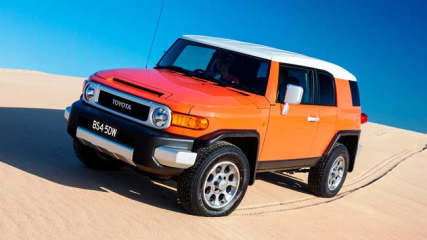
.jpg)
.jpg)

